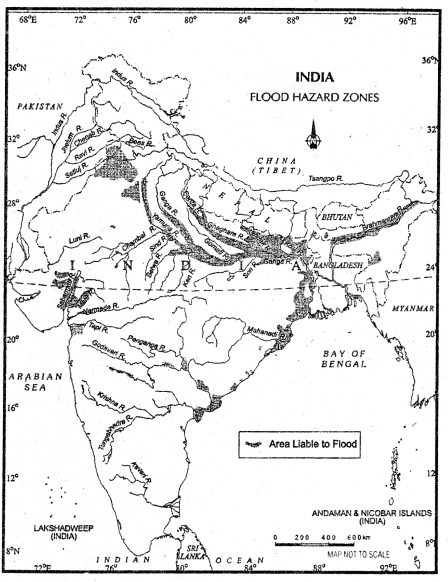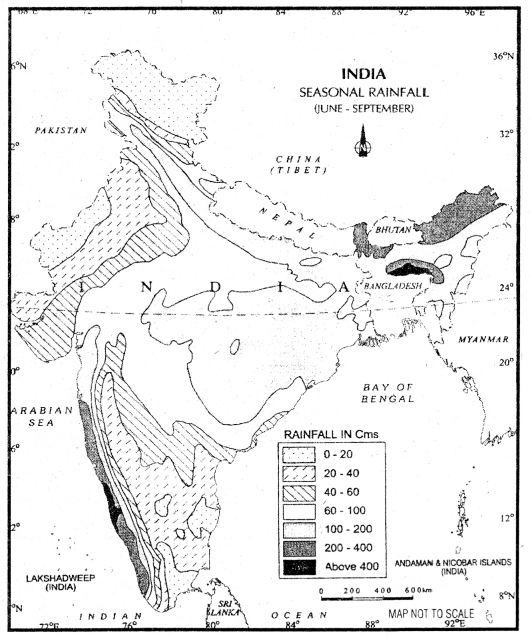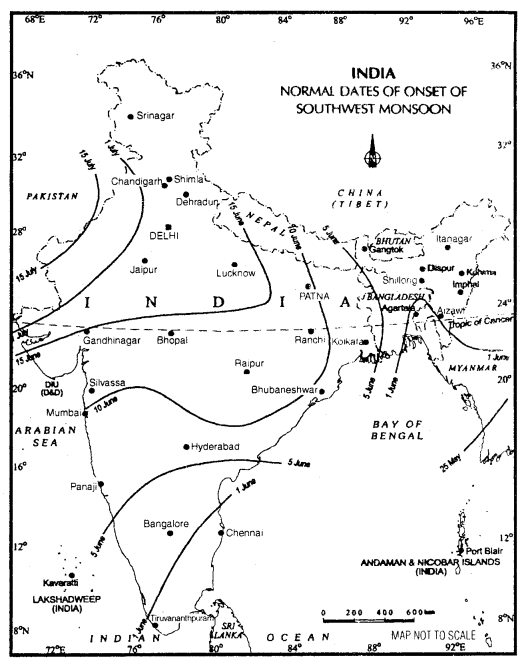Here we are providing Class 11 Geography Important Extra Questions and Answers Chapter 7 Natural Hazards and Disasters. Important Questions for Class 11 Geography are the best resource for students which helps in class 11 board exams.
Important Questions for Class 11 Geography Chapter 7 Natural Hazards and Disasters
Natural Hazards and Disasters Important Extra Questions Very Short Answer Type
Question 1.
What do you mean by disaster?
Answer:
Disaster is a calamity, tragedy, or consequence of hazards.
Question 2.
Name some common natural hazards.
Answer:
Some common natural hazards are volcanic eruptions, earthquakes, droughts, floods, cyclones arid soil erosion.
Question 3.
What is a catastrophe?
Answer:
A sudden or widespread disaster is known as a catastrophe.
Question 4.
What are the causes of human-induced hazards?
Answer:
The human-induced hazards are caused by human activities such as a nuclear explosion, fire, industrial, etc.
Question 5.
What is the use of the Richter scale?
Answer:
It is used to measure the seismic energy radiated by an earthquake.
Question 6.
How are the earthquakes of non-tectonic origin caused?
Answer:
By volcanic eruptions, rock-bursts, subsidence in mines, impounding of reservoirs, etc.
Question 7.
Name the factors on which the intensity of storm waves of a cyclone depends?
Answer:
The intensity of storm waves depends on the wind, speed, pressure gradient, topography, and profile of the coastline.
Question 8.
How does flood occur?
Answer:
The flood occurs when a river overflows its banks and spreads out over the plains.
Question 9.
Which months experience the maximum number of storms in the Bay of Bengal and the Arabian Sea?
Answer:
October and November.
Question 10.
What is a flash flood?
Answer:
It is a sudden violent flood caused by exceptionally heavy rain in a normally dry valley in a semi-arid area.
Question 11.
What is the main cause of drought?
Answer:
The inadequate and uneven distribution of rainfall.
Question 12.
Identify two forms of landslides.
Answer:
Translational and rotational.
Question 13.
What does ‘MB’ stand for?
Answer:
Mb stands for millibar, the unit of measurement for pressure.
Question 14.
What are avalanches?
Answer:
A large mass of snow mixed with earth, stones, and ice loosened from a mountainside and drawn swiftly by gravity to the valley is called avalanches.
Question 15.
Which of the cyclones is more destructive?
Answer:
A tropical cyclone is more destructive.
Question 16.
Name three states which are affected by cyclones.
Answer:
Orissa, Andhra Pradesh, Tamil Nadu.
Question 17.
What is the velocity of a cyclone and its normal duration?
Answer:
20 km per hour.
Question 18.
To which theory the earthquake is related?
Answer:
Plate tectonics.
Question 19.
How much area in India is drought-prone?
Answer:
19%.
Question 20.
What is a landslide?
Answer:
It is the rapid sliding of large masses of bed rocks or regoliths.
Question 21.
What defines the Disaster Management Bill 2005?
Answer:
It defines a disaster as a catastrophe, mishap, calamity, or grave occurrence affecting any area arising from man-made causes.
Question 22.
Name the different types of droughts in India.
Answer:
Four types of droughts: Meteorological, Agricultural, Hydrological and Ecological droughts.
Question 23.
In India which state is flooded during winter?
Answer:
Tamil Nadu coast.
Question 24.
What is ‘storm surge’?
Answer:
The severe cyclonic storms with an average speed of 180 km/h result in a sudden rise in the sea level known as storm surge.
Question 25.
What type of disasters are caused by cyclones?
Answer:
Earthquakes, tsunamis, and volcanic eruptions,
Natural Hazards and Disasters Important Extra Questions Short Answer Type
Question 1.
What is an earthquake and what is its intensity?
Answer:
An earthquake is the sudden movement of the crust of the earth resulting in tremors and vibrations. Like magnitude, the intensity is also one of the ways to measure the strength of an earthquake. Intensity relates to the force of an earthquake. It is the measure of the damage caused by the earthquake.
Question 2.
Name a high and very high-risk seismic area of India.
Answer:
From the earthquake point of view, the high-risk areas are the Ganga plains and western Rajasthan, whereas the very high-risk areas are the Himalayan mountain, north-eastern India, Kachchh, west coast around Ratnagiri and Andaman and Nicobar islands.
Question 3.
What are the basic requirements for the formation of a cyclone?
Answer:
The following are the basic requirements for the formation of a cyclone:
- The temperature of the oceanic surface over 26°C.
- The appearance of a closed isobar.
- Pressure dropping below 1000 Mb.
- Areas of circular movement, first spreading to a radius of 30-50km., then increasing gradually to 100-200 km. and even to 1000 km.
- Verticallythewindspeedfirstrisingtoaheightof6km., then much higher.
Question 4.
What is the velocity of a cyclone and its normal duration?
Answer:
The speed of movement of a cyclone per unit of time is called its velocity. The cyclones move at an average velocity of about 20 km. per hour. Its normal duration is five to seven days.
Question 5.
Mention the flood-prone areas of India.
Answer:
The flood-prone areas of India include the Ganga basin covering Uttar Pradesh, Bihar, and West Bengal, the Brahmaputra basin in Assam, and the Baitarni, the Brahmani and Subarnrekha basins of Orissa.

Fig.7.3 ‘Flood-prone areas of India’
Question 6.
Name two human activities that cause a flood in India.
Answer:
These are the two factors that increase the incidence of a flood.
- Deforestation,
- Drainage congestion (caused by the badly planned construction of bridges, roads, railway tracks, and other developmental activities).
Question 7.
What are the consequences of landslides on humans?
Answer:
There are the following consequences of landslides:
- Damage to planted vegetation and crops.
- Disruption of communication due to the blocking of roads and rivers.
- Destruction of human settlements over slopes and loss of human life.
Question 8.
What is disaster management?
Answer:
The term disaster management includes all aspects of prevention and protection measures, preparedness, and organization of relief operations for mitigating the impact of disasters on human beings and socio-economic aspects of the disaster-prone area.
Question 9.
How embankments worsen the problem of a flood?
Answer:
The construction of embankments, the river water spreads out the stream and flows oven, it worsens the problem of a flood. The width of the river stream becomes narrow and a flood occurs.
Question 10.
What are the major hazards that occur in India?
Answer:
Drought, floods, cyclones, landslides, and earthquakes are some of the major hazards which occur in India. These natural hazards or disasters are the results of sudden earth movements that change the face of the earth in a short period causing heavy loss of life and property.
Question 11.
What do you understand by ‘tsunami’?
Answer:
‘Tsunami’ is a series of waves generates under the body of water by an impulsive disturbance that vertically displaces the water column. Earthquakes, landslides, volcanic eruptions, and the impact of cosmic bodies like asteroids can generate a tsunami.
Question 12.
Define solifluction.
Answer:
Solifluction is the slow movement of rock debris, saturated with water and not confined to definite demands, down a slope under the force of gravity. It occurs particularly when thawing releases such surface deposits while the underlying layers are still frozen. The term is usually applied to saturated deposits.
Question 13.
Define pressure gradient.
Answer:
The amount of change in atmospheric pressure between two points is called the pressure gradient. It is indicated by the distance apart on a level surface of the isobar. Closely spaced isobars indicate a steep gradient and those widely spread represent gentle gradients.
Question 14.
Why north bank tributaries of the Brahmaputra river create more floods than those of the south bank?
Answer:
It is because the northern tributaries have steep slopes, shallow and braided channels, and coarse sandy beds; they carry a heavy silt charge and have a tendency to bring fresh floods. The south bank tributaries, on the other hand, have comparatively flatter gradients and deeper channels, they are clayey and have more stable banks and beds.
Natural Hazards and Disasters Important Extra Questions Long Answer Type
Question 1.
Discuss the three components of the impact phase of disaster management.
Answer:
The term disaster management includes all aspects of preventive and perspective measures, preparedness, and organization of relief operations for mitigation of the impact of the disaster on human beings and socio-economic aspects of the disaster-prone areas.-The whole process of disaster management can be divided into three phases, impact phase, rehabilitation and reconstruction phase, and integrated large term development and preparative phase.
The impact phase contains three components – forecasting of disaster, close monitoring of agents causing disasters, and management activities after the disaster has occurred. As far as forecasting of disaster is concerned, flood forecasting can be done by studying rainfall in the catchment area. The approach of cyclones can be tracked and monitored by satellites. Based on these details, early warning and evacuation efforts may be made.
Close monitoring of agents responsible for disaster can help the deployment of terms to help evacuation and supply of food clothing and drinking water. Disaster leaves a trail of death and destruction. This will require medical care and the help of the affected people. Under the long-term development phase, preventive and precautionary measures of various kinds should be chalked out.
Question 2.
What should people do and don’t do in an area going to be hit by a cyclone?
Answer:
In order to draw the attention of the people of the world, the UNESCO observed International Decade for natural disaster Reduction during 1990-2000. Along with other nations of the world, India observed World Disaster Reduction Day in October during the decade. Do’s and Don’ts for the people in cyclone-hit areas, which were issued by the Government of India are as follows:
- Listen to the radio for advance information and advice. Allow a considerable margin for safety.
- When the storm force winds or severe gales are forecast for your area: store or secure loose boards, corrugated iron, rubbish lines, or anything else that could become dangerous; tape up large windows to prevent them from shattering; and move to the nearest shelter or evacuate the area if this is ordered by the ‘ appropriate government agency.
- When the storm hits it is advisable: to stay indoors and take shelter in the strongest part of your house; listen to the radio and follow instructions; open windows on the sheltered side of the house if the roof begins to lift; find shelter if you are caught out in the open, and do not go outside during a lull in the storm.
Question 3.
Describe the flood in India as a disaster. Write an essay on floods as a disaster.
Answer:
Floods are a major cause of human misery in India every year. Out of a number of natural disasters that the country has experienced, floods are the most important ones. India is the most flood-affected country in the world next to Bangladesh. Twenty percent of the global deaths caused by floods in the world are in India.
In spite of the fact that floods are a natural disaster, it often turns out to be a social disaster as the people who are severely affected are generally the poor because they live on the periphery of the human habitat. The annual flood-affected population has arisen faster than the growth of India’s population. The flood-affected area and damages have also increased recently; the reason for this increase is the encroachment of flood plain by the people.
The most flood-prone basins in the country are those of the Ganga-in Uttar Pradesh, Bihar, and West Bengal, the Brahmaputra in Assam, and the Batumi, the Brahmani, and the Subarnrekha basins in Orissa. Sometimes floods occur also in Andhra Pradesh, Rajasthan, Haryana, and Gujarat.
Flood Control – Floods are not new in India. The practice of building flood protection embankments along rivers is an ancient one. We had flood protection embankments on the Godavari, Krishna, and the Kaveri deltas and in the Indo-Ganga plain.
The nationwide flood protection programs, however, began only after independence. At the time of independence in 1947, India had some 5280 km. of embankments along different rivers. Of this 3500 km. were in the Sundarbans in the West Bengal and 1209 km. along the Mahanadi in Orissa. This provided protection to about 3 million hectares of land.
In 1954 a spate of severe floods came. Enormous devastation was caused in Uttar Pradesh, Bihar, West Bengal, and Assam. Long term programs for the construction of dams and embankments were drawn. Central and state flood control boards were set up. In spite of various measures taken up to minimize the fury of floods, they are still a regular feature in the Ganga and the Brahmaputra basin.
Reducing Impact of Flood-The building of embankments was the only way floods could be controlled in the forties.

Fig.7.3: “Heavily embankment areas of India’
The dams and reservoirs were considered useful to control runoff water and reduce flooding. Now there are several other measures to reduce the severity of the flood. The felling of trees and deforestation on mountain slopes and in catchment areas need control. Weather forecast and flood warning feature is a regular feature.
Question 4.
What is a tsunami? How it occurs and what are its consequences? Describe in detail.
Answer:
A tsunami is a series of waves generated in the body of water by an impulsive disturbance that vertically displaces the water column. Earthquakes, landslides, volcanic eruptions, and even the impact of cosmic bodies such as asteroids can generate a tsunami. When the Indian plate in the north-east gets locked with the Eurasian plate, it creates high stress, and the accumulation of high energy causes an earthquake.
Cause – Nomially the seismic waves cause only one instantaneous vertical wave but after the initial disturbance, a series of after waves are created in the water that oscillates between the high crest and low trough in order to restore the water level. The speed of waves in the ocean depends upon the depth of water. It is more in shallow water than at the ocean depth.
Consequences – The impact of the tsunami is less over the ocean and more near the coast where they cause large scale devastation. Therefore, a ship at sea is not much affected by tsunamis. The tsunami wave raises the ship only one meter because over deep water tsunami has a very long wavelength and limited wave height. Over shallow water, tsunami causes large-scale destruction along the shores, here wavelength gets reduced and height can be up to 15 meters.
- After reaching the coast they release enormous energy and destroy the port cities and towns, structures, buildings, and other settlements.
- The loss of property’ and life by the tsunami is much higher as compared to other natural hazards in the coastal areas.
Mitigation steps – It is difficult to mitigate the hazards caused by the tsunami because of the fact that losses are on a much large scale.
Question 5.
What is an earthquake? Discuss the causes and consequences of an earthquake.
Answer:
An earthquake is a sudden movement of the crust of the earth. An earthquake occurs when the Indian plate gets locked up with a Eurasian plate, high stress is developed which results in the release of high energy. It is a sudden shaking of the crust which results in tremors and vibrations.
Causes – The following are the causes of earthquakes:
- Volcanic eruption
- Tectonic causes
- Elasticity of rocks
- Local causes
Consequences –
- If the intensity of an earthquake is more than 6 on the Richter scale, there is a loss of life and property on a large scale.
- In the young fold mountains, the earthquake leads to cracks in the rocks and causes landslides.
- Due to earthquake, there are short circuits of electrical wires which damage and blast the equipment.
- Usually, earthquakes lead to distortion and displacement of the surface rocks which block the flow of the river coming in the ways.


